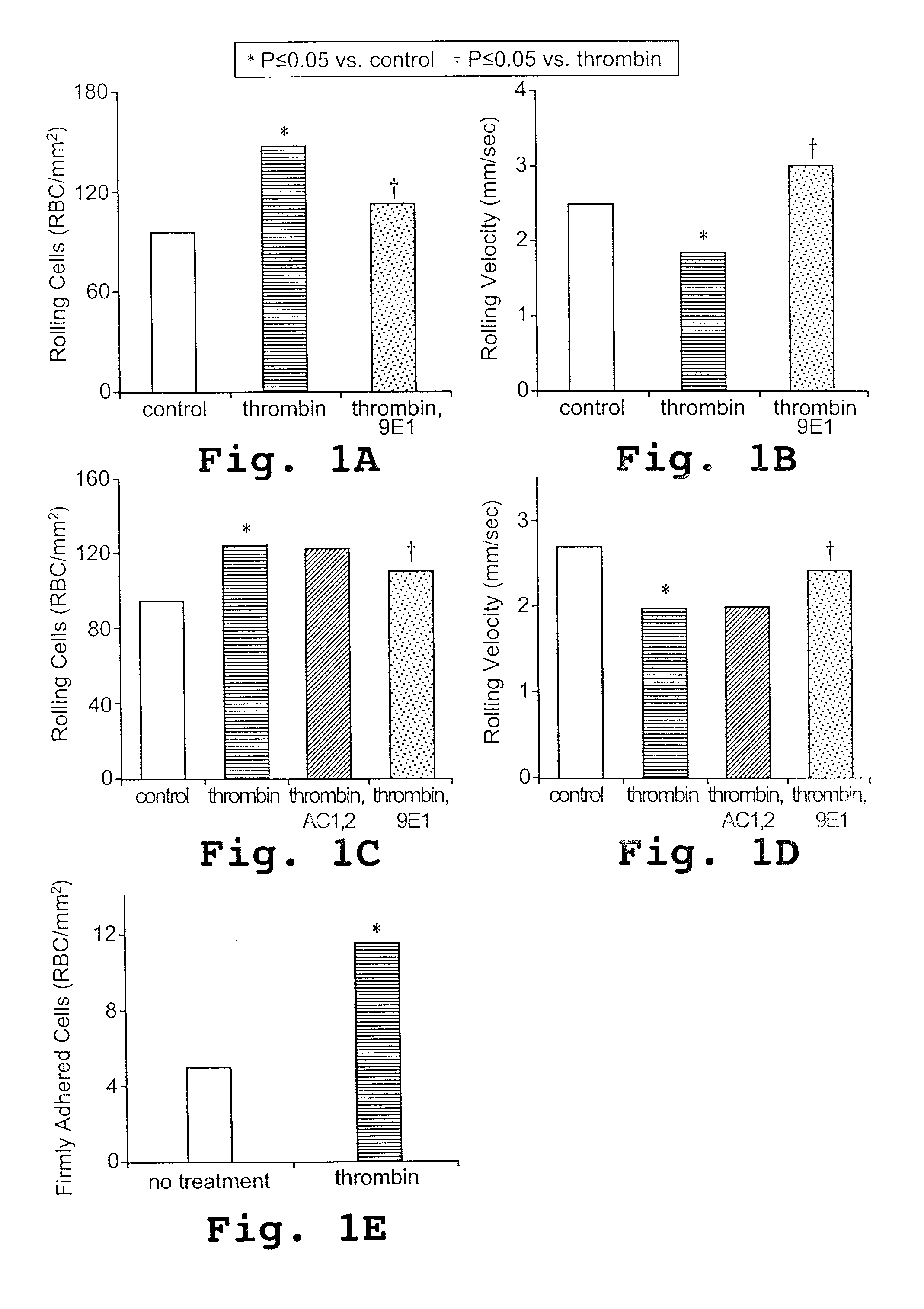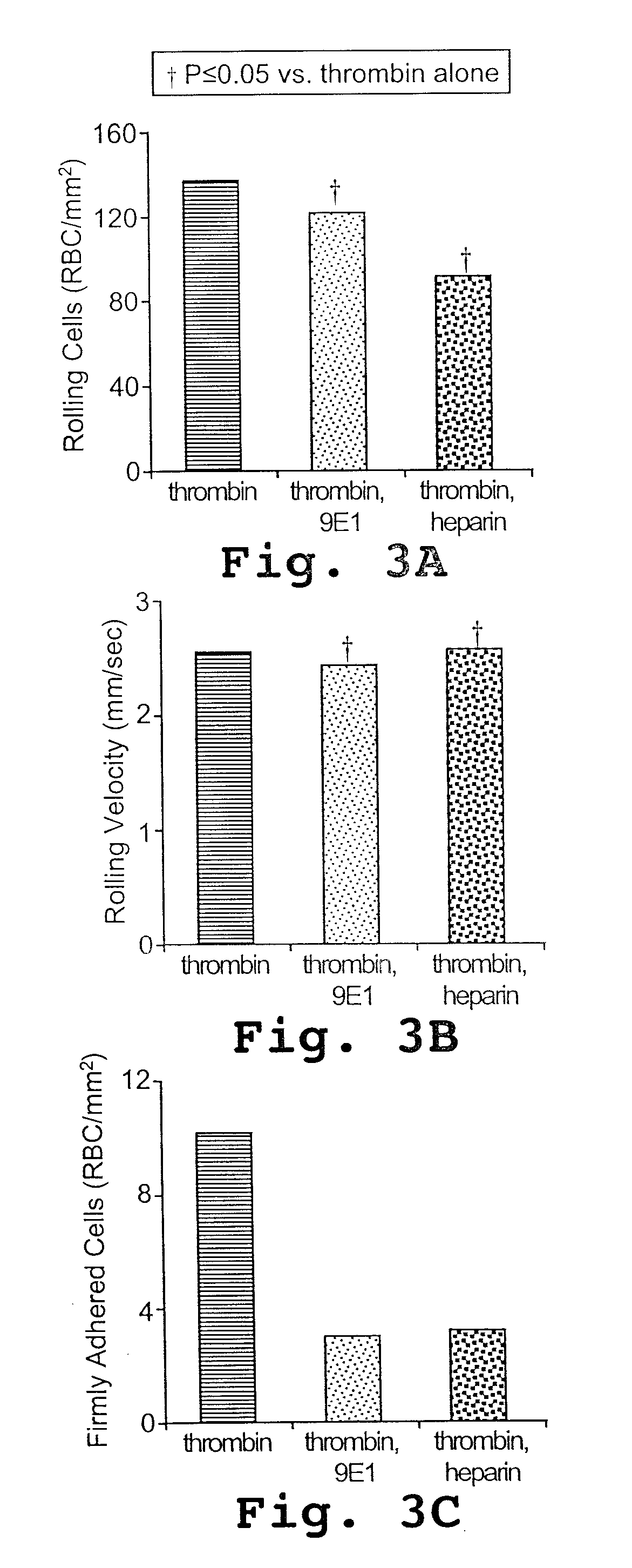Method and composition for preventing pain in sickle cell patients
a technology for sickle cell patients and compositions, applied in the field of compositions and methods for preventing or reducing can solve the problems of delayed transit of sickle red cells through small vessels, persistent sickling, organ failure, etc., to enhance the blood flow and/or prevent pain in sickle cell patients, and enhance the vascular endothelial well-being, the effect of enhancing the blood flow of the microvascular blood flow
- Summary
- Abstract
- Description
- Claims
- Application Information
AI Technical Summary
Benefits of technology
Problems solved by technology
Method used
Image
Examples
example 1
[0123] P-selectin mediates the adhesion of sickle erythrocytes to the endothelium
A. Blood Samples
[0124] Heparinized blood samples were obtained from subjects with sickle cell disease and from healthy control subjects with approval of the Committee on Human Research of the University of California, San Francisco.
B. Thrombin Treatment of Endothelial Monolayers, Static Gravity Adherence with Dip Rinse and Adherence Inhibition Assays.
[0125] Thrombin treatment of human umbilical vein endothelial cells (HUVECs) and the static gravity adherence assay with dip rinse were performed as previously described. When 90% confluent, HUVECs (Clonetics, San Diego, Calif.) were treated with 0.1 U / mL thrombin (Sigma Chemicals, St Louis, Mo.) or medium alone for 5 minutes before assaying erythrocyte adherence. Adherent RBCs were counted microscopically in 8 randomly selected 0.15-mm2 fields for each study condition. The adherence data may be presented as percent adherence where 100% is the mean ad...
example 2
[0149] Heparin inhibits the flow adhesion of sickle red blood cells to P-selectin
A. Preparation of Erythrocytes
[0150] Blood samples obtained from subjects with sickle cell disease and from healthy control subjects, as approved by the Committee on Human Research at the University of California-San Francisco (UCSF), were drawn into citrate. The buffy coat was removed after the initial centrifugation and after each of 3 subsequent washes of the remaining erythrocytes in phosphate buffered saline (PBS) and one wash in HAH buffer (Hanks balanced salt solution [HBSS; UCSF Cell Culture Facility, San Francisco, Calif.], 1% bovine serum albumin [BSA, Fraction V; Sigma, St Louis, Mo.], 50 mM HEPES [N-2-hydroxyethylpiperazine-N′-2- ethanesulfonic acid; Sigma], pH 7.40). Erythrocytes to be used in flow adhesion studies were suspended to a 0.5% hematocrit. To assess for leukocyte contamination, the erythrocyte preparation was exposed to 10 μg / mL rhodamine 6G, which stains leukocytes but not e...
example 3
Generation of LMWH
[0177] Rationally designed LMWHs were generated through the controlled cleavage of porcine intestinal mucosa heparin with a mixture of heparinases. Briefly, to 1 g of porcine intestinal mucosa in 50 ml of 50 mM calcium acetate buffer, pH 6.7, 0.1 molar equivalent of a heparinase mixture was added, and the solution was maintained at 37° C. for 4-8 h. After precipitation of the enzyme, the supernatant was loaded onto a 1-m long, 10-cm diameter P10 size exclusion column. Saccharide fragments were eluted by using a running buffer of 100 mM ammonium bicarbonate, pH 9.0. The eluent was tracked by UV absorption at 232 nm, and 3-ml fractions were collected after the initial void volume. The fractions yielding positive UV absorption at 232 nm were collected and pooled. The sample was lyophilized to remove ammonium bicarbonate and redissolved in ultrapure water.
PUM
| Property | Measurement | Unit |
|---|---|---|
| average molecular weight | aaaaa | aaaaa |
| average molecular weight | aaaaa | aaaaa |
| average molecular weight | aaaaa | aaaaa |
Abstract
Description
Claims
Application Information
 Login to View More
Login to View More - R&D
- Intellectual Property
- Life Sciences
- Materials
- Tech Scout
- Unparalleled Data Quality
- Higher Quality Content
- 60% Fewer Hallucinations
Browse by: Latest US Patents, China's latest patents, Technical Efficacy Thesaurus, Application Domain, Technology Topic, Popular Technical Reports.
© 2025 PatSnap. All rights reserved.Legal|Privacy policy|Modern Slavery Act Transparency Statement|Sitemap|About US| Contact US: help@patsnap.com



